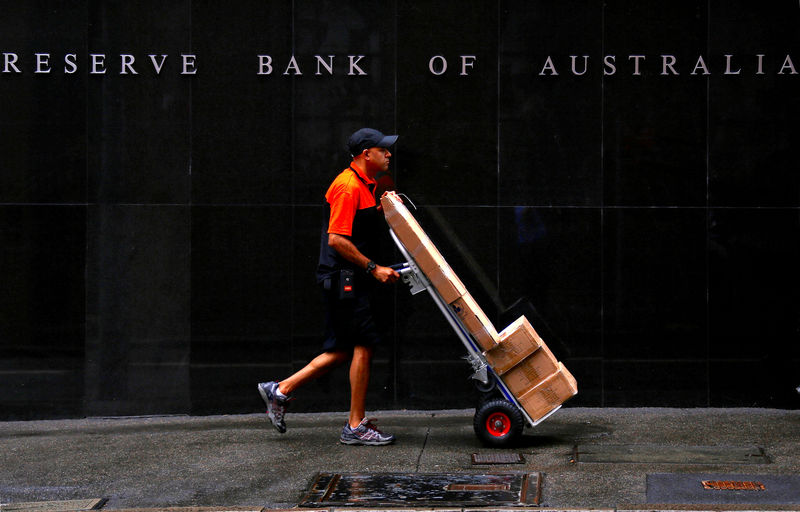 © Reuters. FILE PHOTO – A worker delivering parcels pushes a trolley past the Reserve Bank of Australia building in central Sydney, Australia
© Reuters. FILE PHOTO – A worker delivering parcels pushes a trolley past the Reserve Bank of Australia building in central Sydney, AustraliaBy Swati Pandey and Wayne Cole
SYDNEY (Reuters) – Australia’s central bank stuck to its upbeat view of the economy after it held rates at record lows in a widely expected move on Tuesday, just a day before GDP data is likely to show domestic momentum almost stalled last quarter.
The Reserve Bank of Australia (RBA) ended a 30th straight meeting with rates at 1.50 percent and signaled a steady policy outlook as it awaits a pick up in economic growth and inflation.
That wait may prove longer with a run of soft data from consumption to housing this week leading analysts to downgrade forecasts for fourth-quarter growth to near nothing. Official figures on gross domestic product (GDP) are due on Wednesday.
A weak number could jeopardize re-election prospects for Australia’s centre-right government which has been pitching “jobs and growth” as its key economic mantra.
The Liberal-National government faces a tough election in May and is widely expected to entice voters with tax cuts and more spending in its annual budget on April 2.
Analysts polled by Reuters suspect the economy expanded by a sub-par 0.3 percent in the December quarter, after a disappointing 0.3 percent rise in the third quarter.
Annual growth is seen slowing to 2.5 percent, from 2.8 percent, making the RBA’s call for 3 percent this year look increasingly optimistic.
A flat print could lead the RBA to shift to a dovish stance from its current neutral bias, Citi economist Josh Williamson said in a note. The central bank last month abandoned its long-held tightening bias.
RBA Governor Philip Lowe acknowledged Australia’s A$1.8 trillion economy may have slowed over the second half of 2018. Still, he held out the hope for growth to pick up to around 3 percent this year led by rising business investment, higher government spending and stimulatory monetary policy.
Another reason for the RBA’s confidence in the economic outlook is a robust employment sector.
“The stronger labor market has led to some pick-up in wages growth, which is a welcome development,” Lowe said in a brief statement accompanying the bank’s rate decision.
“The improvement in the labor market should see some further lift in wages growth over time, although this is still expected to be a gradual process.”
Lowe again pointed to household consumption as “the main domestic uncertainty” especially given anemic wages growth and sliding housing prices in the nation’s biggest cities of Sydney and Melbourne.
So far, Lowe has played down the damage done by the fall in home values, noting that it comes after a decade of booming prices. The housing market will be the topic of his speech on Wednesday.
A CUT?
The RBA’s overall optimism isn’t shared by many economists who expect a slowdown in domestic activity this year would push the central bank to further ease policy.
Interest rate futures are pointing to an 86 percent probability of a cut to 1.25 percent by the end of this year.
Lowe has conceded that an easing in the 1.5 percent cash rate might be contemplated if the labor market takes a turn for the worse and unemployment starts to rise from the current 5.0 percent.
“We think rate cuts this year, while not guaranteed, are now more likely than not,” said Nomura economist Andrew Ticehurst.
“At heart is a weaker regional and global growth environment, which comes at a poor time for Australia, given the local dynamics of a ‘stretched’ consumer.”
He is tipping a cut in both July and August, taking rates to a new all time low of 1 percent.
Data out earlier showed net exports trimmed 0.2 percentage points from GDP, double that expected by analysts.
A saving grace came from government spending which added a bit more than 0.3 percentage points to GDP in the quarter.
Public spending accounts for almost 24 percent of Australia’s annual GDP and a much-needed binge on infrastructure is proving a crucial supporter of growth across the economy.
Source: Investing.com





























